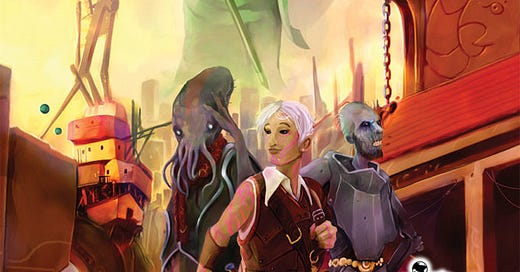Dungeon World has fallen out of favor these days for a host of reasons. It has been interesting to see some recent games try to position themselves as the successor it. OOH it’s also a situation which has spawned many discussions about the kinds of worlds it could simulate and the limitations of some of the base assumptions. Is Dungeon World hobbled by being a PbtA approach to D&D tropes? It’s a conversation I’ve seen more times than I care to.
What is interesting to me is the host of striking and unique settings built for DW over the years. It’s worth looking through those to find the bits and pieces we could adapt for other games. One of the best of those is The Green Law of Varkith. That’s part of a trio of DW supplements from Magpie with The Last Days of Anglekite doing big world-ending fantasy, The Cold Ruins of Lastlife being heavily inspired by Dark Souls, and the last one, Varkith, having the general feel of Planescape.
Varkith is rich with interesting ideas. The non-human races presented in the game and novel and great. They’re the kind of thing I’d like to see more of: truly alien folk. There’s also a mechanic for the players creating and developing a company, called a Guild here. That’s the main point of the setting– which is cool but also puts some rails on play that some players may not be into. I ran into that a couple of times where the premise of the game’s weird city and rules created non-productive friction.
But there’s one element of Varkith I think worth borrowing: faction management. It feels a little like Blades in the Dark. That has a Crew which is the equivalent of your Guild. It has factions at various levels of scale operating in the background, but they’re often more static. Those factions move when the PCs interact with them directly or post-mission blowback activates them. This more passive approach is similar to other games like The Sprawl and Mutant: Genlab Alpha.
Everything in Varkith is organized around Guilds, not just PCs. Unlike Planescape’s Sigil, here players belong to that core guild they run, rather than being associated with different factions. Guilds have stats, purposes, and styles. The cycle of play moves between character turns and guild turns. In a Guild Turn, the PCs take a single guild action for free and then may pay to take additional actions. These include Violently Attacking Another Guide, Seize Territory through Force, Collect Information, Discern Strengths and Weaknesses, Strike a Deal with Another Guild, Manipulate the Legal System, Interfere with Another Guild, or Perform a Ritual.
There’s an additional economy for Coin, Markers, and Rank. The really smart part is this: after the PCs have taken their Guild Actions, the GM also runs down through the different Guilds, giving them each an action. It builds up a set of events and maneuvers happening in the background. There’s some really cool mechanics for how to manage this. It’s a dynamite way to manage things.
For several campaigns now I’ve used that system but with a slight modification. Instead of choosing which action a faction takes, I roll that randomly. Then, if the action targets another faction, I randomly roll to see which one. I will sometimes modify that if the target is obvious. I also added a few new Guild Actions to the mix. To track this out I create a grid matrix to record the factions and their maneuvers. I color code the responses so I can see how things shift over time. It’s a dynamite tool for building up what’s happening in the background of the world and always creates new and interesting hooks.
You can see me talk a little more about this and exactly how I use this tool here.




